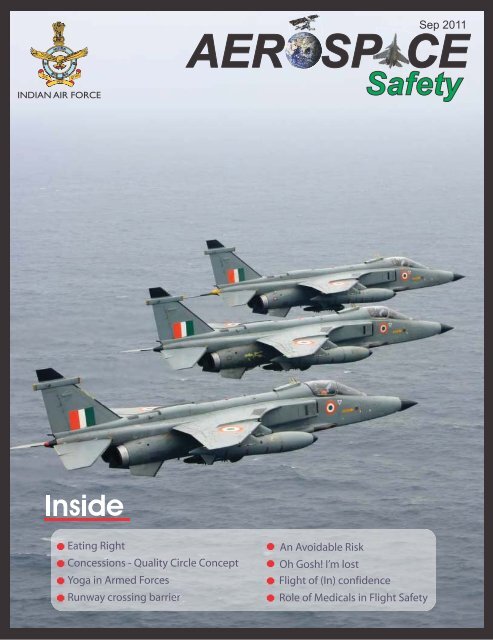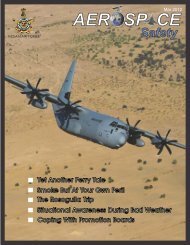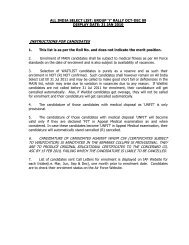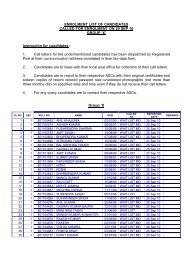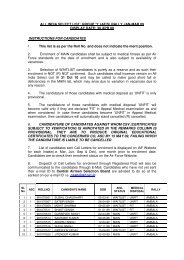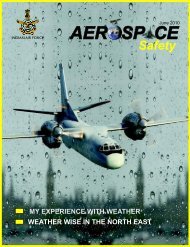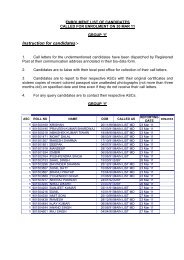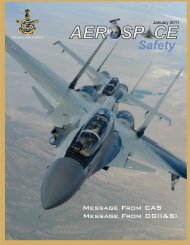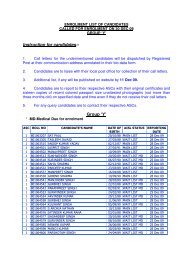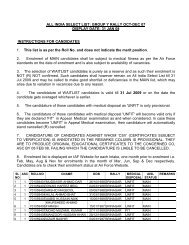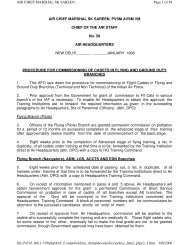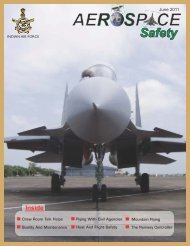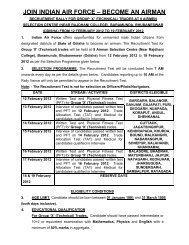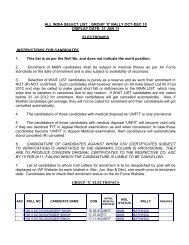Sep 11 - Indian Airforce
Sep 11 - Indian Airforce
Sep 11 - Indian Airforce
Create successful ePaper yourself
Turn your PDF publications into a flip-book with our unique Google optimized e-Paper software.
With this motto let us deliberate on how tochoose the right food which is one of the keyingredients to our fitness.Wg Cdr GS BishenEvery day we are faced with abundance of foodand nutrition information and choices. Whether itis maintaining a healthy diet while eating at yourfavourite restaurant, navigating the shelves at yourlocal grocery store or fuelling up for an upcoming 5km run. Making the right food and nutrition choices isa necessary part of everyone’s daily life.Eating healthy, eating right is all about beingan informed consumer. First and foremost we mustfigure out whether we ‘live to eat’ or vice versa. Healthis man’s biggest concern in today’s day and age inorder to balance the pressure of work and family. Abalanced diet is when we have all the nutrients likeproteins, carbohydrates, fats, vitamins and minerals inright amount. But right eating is the kind of food ourbody needs to keep our weight in proportion to ourbody.Goal: Peak operational readiness, 24x7 at anyplace.Road Map: Maximise efficiency with a healthybody and mind.“The army marches on its stomach”.NapoleonSo does the Air Force... (My personal take)It is extremely important to be aware of the foodswe eat, their nutritional value and why and how it isgood for us. Most of the food that we consume losesits nutritional value due to over cooking or excessiveuse of spices. Therefore we must be very strong willedso as not to consume foods only suiting our taste buds.We must choose to have foods, the nutrient values ofwhich are suited to our body shape, blood type andage. Every individual’s nutritional requirement isdifferent from the other. Therefore no one should copythe other person or follow just any diet plan which issuggested in the news papers and magazines. Wemust consult a specialist or read up on our body typeand then only plan what is good for us.We are very fortunate to be in a country like ourswhich is so rich in agriculture. We produce almost allthe fruits, vegetables, cereals and dairy products on alarge scale throughout the year. Even poultry is veryreadily available in every part of the country.Getting fresh foods throughout the year, isit self a boon. In foreign countries freshfruit and vegetables are very rare4 Aerospace Safety S e p t e m b e r 2 0 <strong>11</strong>INDIAN AIR FORCE
and expensive due to extreme weather conditions.We must value such availabilities and make theright use of them. I recall attending a talk by anutritionist from UK in late 90’s at Taj Main, Mumbai,who said that a country like ours in general, followsa great diet which is so nutritive. A meal whichincludes chapatties, dal, vegetable and curd isextremely healthy and probably very commonin all <strong>Indian</strong> homes. These things are not readilyavailable abroad. They have bread which is bakedwith maida (refined floor not so healthy) and meatwith an occasional salad as their staple diet.The problem here is we do not value what wehave. A breakfast should include a cereal with milkand fruit or chapattis with some green spread oregg. Do not try to have things which are difficultto procure and assume that they may be healthy.Even inexpensive things may be equally healthylike having chapattis instead of brown bread orMuesli, dates instead of hazelnut or dry fruit. Oursalads and fruits should not be topped with heavydressings.Parties are a regular feature in the Services,but its not handled well by many especially if itsrepeated a couple of times within a short span oftime. Choose your drinks according to your taste,preferably do not mix or change drinks, keep withinlimits. Have light snacks like cut salad with dips. Ifyou know its going to be a late night, avoid having aheavy dinner. Eat food that is easily digested like ricewith a single gravy dish. Remember your stomachis not a dustbin, so do not gorge on rich party foodinstead be very particular in what you are going totreat your Tummy with, so that you do not get upwith acidity and heart burn next morning.Tips for a Healthy Diet Breakfast is a must, even if you have an earlymorning take off. Grab a couple of toasts with yourmorning cup of tea, even left over chapattis fromprevious night should do. Help yourself prepare / cook meals if needarises. Do not depend on others. Home cooked food is the best option unlessthere is no choice at all. Chapatties are better than bread since they aremade of whole wheat flour. In between snacking should be avoided, insteadhave plenty of seasonal fruits. Avoid having fruit juices, since they have a highsugar content. Be careful of the timings of your meals, a latedinner should be avoided. There should be a gapof minimum two hours between dinner and sleep.Food does not digest well if you sleep immediately.Therefore, a night walk is recommended.Some easy and healthy cooking tips. Wash your vegetables thoroughly in potassiumpermanganate water especially during the rainyseason. Microwave or steam chopped veggies beforefrying. Use spices and seasoning in a limit since theyonly increase blood pressure and other commondiseases. Use homemade chutneys without oil ratherthan pickles as add-ons in your meals or even assalad dressings. A lightly fried chana (roasted), puffed rice(murmura) in a little oil with seasoning makes agood accompaniment not only with evening tea butalso with drinks. Avoid red meat, lean meat is healthier.Each one of us wants to be physically fit andmentally satisfied. If we eat right, we will remainhealthy, if we are healthy it’s easy to take on any taskassigned to us at our work place. Therefore bewareof what and when you eat, bring awareness of thesame to your family me mbers and colleagues.Eat right, keep fit, look young, work well and feelgood. A healthy body harbours a healthy mind, bothequally important to maintain excellence in ourwork output. We can collectively maintain our peakoperational readiness with highest safety standards.-Wg Cdr GS BishenINDIAN AIR FORCE 2 0 1 1 S e p t e m b e r Aerospace Safety 5
Sqn Ldr Sanjeev Wazir6 Aerospace Safety S e p t e m b e r 2 0 <strong>11</strong>INDIAN AIR FORCE
This incident happened in 2004, when I wasposted to a premier fighter base of CAC. Iwas detailed as the DATCO (Duty Air TrafficController) in the ATC. It was a busy flying day asusual with three flying Sqns operating. The lastaircraft of the ‘First detail’ was cleared by ATC forlanding. When this ac was on short finals, theAOLO (Airman On Look Out) reported that themanual traffic barrier was open and a scooteristwas crossing the R/W. By now, I noticed that theac was on landing roll, but I still cautioned thepilot about the ‘Scooter’ on the runway. In thisprecarious situation there was nothing muchthe pilot could do, however the scooterist justmanaged to save himself from a collision byjumping away in the nick of time.Subsequent investigations revealed that dueto fluctuations of electricity, the hooter of theelectrical barrier had come ‘On’ automaticallyand the person guarding the barrier thought thatthe ATC tower wanted him to open the electricalbarrier. Due to some fault he could not operatethe electric barrier so he opened the manualbarrier. On seeing the barrier open, the scooteristhad proceeded to cross the runway.Later, it was also realised that it was thescooterist’s first posting to a flying base. He wasnot aware of the rule position for runwaycrossing. After the incident, an inquiry wasconducted to investigate the problemsassociated with barrier operation. It wasfound that intermittent operation of theelectrical barrier, was a routine thing.Certain recommendations to obviate similarrecurrence are:- Runway crossing should be totallystopped. Crossing the runway, also contributes tocases of ‘Foreign Object Damage’ to our ac. Runway crossing if required, should betotally under the control of ATC tower bymeans of Motorola and the barrier man.All efforts should be made to obviate anycommunication gap. All air warriors coming from non-flyingstations should familiarise themselves withthe rules and regulation to be followedwhile moving around the ac maneuveringarea.- Sqn Ldr Sanjeev WazirINDIAN AIR FORCE 2 0 1 1 S e p t e m b e r Aerospace Safety 7
Wg Cdr V MathurIn the interest of flying safely itis essential that all maintenanceactivities in the Air Force shouldstrictly conform to the laid downinstructions. It also follows thatservicing of the aircraft is carried outaccording to the laid down servicing/test schedule and Modifications/STIs/SIs incorporated when due asper specified specifications. However,situations may arise when either due tonon availability of spares /publicationsor in the interest of operationalcommitment or to facilitate production it maybecome necessary to deviate from the laid outschedule provided such deviation does not affectthe safety of the aircraft or person /equipment.CONCESSION, in the Air Force parlancemeans a deviation in servicing activity due to nonavailability of a tester / spare/publications withwhich an aircraft could still fly within the envelopof flight safety. The whole gambit of concessionsis undertaken to ensure safe operations in caseof scarcity or in other words it is the calculatedrisk taken by the ‘Group’. To be able to safely fly8 Aerospace Safety S e p t e m b e r 2 0 <strong>11</strong>INDIAN AIR FORCE
a machine in times of scarcity. We have an AFOwhich deals with the concessions and also directsthe members of the group to take responsibilityfor the same.The ageing fleet of a large number ofaircraft in the Air Force face the problems of nonavailability of mandatory, ARS/ Non ARS sparespublications/testers causing the units to raisedemands and take concessions on the same.The procurement procedures involved in theirbulk purchase from foreign vendors /originalequipment manufacturer often takes months dueto obsolesce and outdated requirements whichare no more in use in other countries. Hence,it is the responsibility of the units to conserveand preserve them as far as possible and alsopredict their advance requirements to concernedagencies.Frequent grant of Concessions certainly leadsto lowering down of the Quality of the productand may result in jeopardising aviation safety.Therefore, the following points needs to be strictlycompiled while granting concessions: Ensure that strength, functioning, interchangeability or safety of aircraft and or personnelis not affected.Clearly indicate the period of concession Concessions for transport aircraft are to begranted for periods of not more than 6 months/ next 250 hours/nearest minor servicing whichever is earlier For fighter / bomber aircraft concessions areto be taken for periods not more than 6 months/ next 125 hours / nearest minor servicing whichever is earlierThus, the only remedy in such dire situationsis to fly the aircraft on concession for a particularperiod. This is often resorted to withoutconsidering the overall effect of the concessionand may lead to disastrous situation on the whole.An example of a fall out of concession is a case offire which took place in one of the MI-17 unit thisyear, where the loom of a cable passing beside theengine panel had shorted, causing a fire during DIof the ac. The anti icing system was on concession.Thus, its cable loom was not being inspected dueto its difficult location. Eventually it shorted dueto a cut on its insulating sheath. The other tradesmen too were not cautious as the disused cablewas not in the sight but hidden under the panel.Thus, a total insight in to a concession is requiredto be taken. A concession should be in all casescoupled with a secondary maintenance activity ifthe main cannot be performed. For example, thesystem be checked by possible alternate methodsat a given periodicity in case of concessionsfor the main activity is not possible due to nonavailability of tester and spare with more stress onsafety and integrity. This alternate activity couldbe thought at unit /BRD level in consultation withall the ‘USTADs’ of all trades including aircrew fortheir valuable inputs. This is the concept of QualityCircle on Concessions and is more apt in the timesof scarcity as it gives positive directions to themaintenance staff in absence of the spare/ tester.There are a large number of concessions onthe ageing fleet of MI-17, AVRO, AN32, MI-8 etcwhich have been taken for a long period due tovarious non availability of spares and should betackled in a two pronged attack. Firstly, our effortshould be to procure the items or indigenise thesame in the BRD / HAL. Secondly, form a ‘Qualitycircle’ to suggest alternate and equivalent methodsof testing the same in the fleet. Initially theconcessions should be granted for a period of twomonths in which necessary important inputs fromthe field units are taken and an alternate servicingplan with necessary justification is approved bythe BRD/HAL before finalising the concession fora longer period. The implementation of thesepolicies will go a long way in preventing incidentsin our ageing fleets.- Wg Cdr V MathurINDIAN AIR FORCE 2 0 1 1 S e p t e m b e r Aerospace Safety 9
Sqn Ldr A SangwanHow often do we find ourselves unableto perform our activities properly and ina satisfying manner due to confusionsand conflicts in our mind? What if every personwas aware of their intrinsic value and dignityas a human being? What if they knew how torespond to life’s challenges with a calm, clearmind and an open heart? How different wouldour communities be? How different would ourworld be? Considering the scenario in armedforces where stress & fatigue are major let downsin a high demanding environment, there is anurgent need to devise ways & means to overcomethese setbacks.In this article, I aim to bring out the conceptof Yoga as a stress and fatigue buster and suggestmethods to incorporate it in our organisation.10 Aerospace Safety S e p t e m b e r 2 0 <strong>11</strong>INDIAN AIR FORCE
Goal Of YogaYoga is a philosophy and discipline appliedto the development of mind and body. Yogapractices consist of concentrated stretchingbased on prescribed sequences of body positions,or asanas. The movement patterns are coupledwith bringing attention away from thinkingand into the internal feeling space of the body,where breath is used to harness the mind andbody together. The practitioner increases bodyawareness, posture, strength, flexibility, andcalmness of spirit. Yoga helps to harness theenergy of the mind so that the mind and bodyare united. Yoga literally means “to yoke the mindand body together”, so that your thoughts are nota thousand miles away from what your body isfeeling and sensing. The ultimate goals may rangefrom reaching Moksha to physical immortality.Relevance In <strong>Indian</strong> Air ForceWith an increasing number of organizationstaking up to the wonderful practice of Yoga tofacilitate mental health, stress reduction, angermanagement and self-discovery it’s necessitycannot be overemphasized.Almost all the branches of the <strong>Indian</strong> Air Forceand specially the flying branch endure a largequantum of stress & fatigue everyday. Stressesrelated to promotions, meeting deadlines, longworking hours, etc may lead to reduction of focusand creeping of irritability amongst the personnel,thereby affecting the quality of work output. Iteven leads to deteriorating interpersonal relationsdisrupting the harmony within the organization.In an extreme case it may lead to development oftensions within the families also. All such troublescombined with the pressures of flying may pushan individual towards acquiring negative traitsand indulgence in activities detrimental to theinterests of the organization.Statistics show that health problems suchas high blood pressure, heart problems, andoverweight problems are on the rise in thesociety as a whole and armed forces are notimmune to it in any way. The number of cat Ccases is on a rise in the <strong>Indian</strong> Air Force bringingdown the productivity. Yoga has both preventiveand therapeutic benefits. It has been shown tooffer both physical and mental benefits to thebody and the mind. A near perfect fitness routine,yoga would provide the means for people of anyage not only to get and stay in shape but also todevelop balance, coordination, and a sense ofcenteredness.Circumstances linked particularly to armedforces such as field/hard area postings andfrequent detachments involving long separationsfrom the family add on to the daily fraction ofstress. Yoga would go a long way in acting as ade stressor in such situations. A consistent yogapractice can quiet the mind and refresh the body,bringing health, relaxation, and happiness.Zero error syndrome is another big stressplaguing us today. In pursuit of excellence mostof the personnel turn into Type A personalities.They get result oriented and are not ready toaccept any failures on their part primarily to keepup their prestige and secondarily due to the fearof the unknown. This habit causes heavy stressamongst the personnel as they are always tryingto achieve 100 % results. Yoga has been proved tobe extremely effective in reducing these kinds ofstress by calming the mind.In addition to various other types of stressthe stresses involved with flying can greatlyaffect the performance of aviators. With nearly80 percent of aircraft accidents being attributedto human factors, there’s an increasing need totake proactive steps towards reducing stress andfatigue amongst pilots.Increasing number of psycho-social problemsrelated to children, parents, property, finances,poor living conditions, etc are also irritantscausing stress amongst Air force personnel. WhileINDIAN AIR FORCE 2 0 1 1 S e p t e m b e r Aerospace Safety <strong>11</strong>
“Yoga practice every day for 20 to30 minutes would give most of thehealth benefits. A typical routine canbe set, keeping aside a time when one will notbe disturbed and one will not have to rush. It isbest to practice yoga on an empty stomach and isadvisable to wait at least two to three hours aftera large meal, and one to two hours after a lighterone or a snack before beginning.the organization is trying its best, it would definitelyneed some time to redress these problems. Insuch situations where the individual as well as theorganization are under stress, Yoga can be of greathelp. It would help not only to bring down thestress levels amongst the personnel but also showthem a direction towards keeping good healthand developing self confidence.Yoga would go a long way in redressingthese kinds of health and psychological problemsspecific to the <strong>Indian</strong> Air Force.Benefits Of YogaEveryone can benefit from following a regularyoga routine, as it counteracts many of theproblems suffered in modern life. It manifestsinto manifold benefits such as increasing mentalclarity, concentration, and focus. It helps build selfesteem,confidence and provides direct accessto mental and physical relaxation. And majorly itprovides practical tools to reduce stress which inreality is the number one killer affecting all partsof our physical, endocrinal and emotional systems.It frees the practitioner physically and mentally,often heightening intuition and creativity.The enormous physical benefits are just a “sideeffect” of this powerful practice. What yoga doesis harmonize the mind with the body and thisresults in real quantum benefits. It would tum outto be specially beneficial for the aged personnelwho are unable to do physical exercises as theycan resort to Pranayam. It is now an open secretthat the will of the mind has enabled people toachieve extraordinary physical feats, which provesbeyond doubt the mind and body connection.How And When To PracticeUnlike conventional forms of exercise, such asweight training, walking, biking or jogging, yogarequires nothing other than a clean airy spaceand an exercise mat. Yoga practice every day for20 to 30 minutes would give most of the healthbenefits. A typical routine can be set, keepingaside a time when one will not be disturbed andone will not have to rush. It is best to practiceyoga on an empty stomach and is advisableto wait at least two to three hours after a largemeal, and one to two hours after a lighter one ora snack before beginning.To cater for all these necessities keepingin mind the curriculum of service activities thebest time to do yoga would be either in themornings from sunrise to one hour after or in theevenings , substituting PT for one or two daysdepending upon organizational commitments.People looking for immediate benefits may getdisappointed and discouraged as the effectsstart showing up only after regular practices ofat least three to four months. But thereafter theeffects of yoga are phenomenal when practicedregularly.12 Aerospace Safety S e p t e m b e r 2 0 <strong>11</strong>INDIAN AIR FORCE
RecommendationsThe following measures arerecommended to incorporate yoga practicesin the <strong>Indian</strong> Air Force: Voluntarily not many people wouldtake up to yoga, primarily due to inertiaand laziness and secondarily due to lackof knowledge. Therefore, there is a need toinstitutionalize it and accept it as a part ofour daily activities. Yoga may be incorporated in the presentcurriculum in addition to or replacing PTfor a few days catering for organizationalcommitments. It may be done collectively instation auditoriums or sports ground. Its awareness can be encouraged byincorporating it in all the training institutesmaking it a part of their curriculum. Only basic yoga can be resorted to withthe primary aim of improving health andfitness and reducing stress. The GTI’s can be instructed in their initialstages at training institutes making it a partof their curriculum. Additionally, selectedpersonnel can be made to undergo coursesin basic yoga, who can later on educateothers. Making use of a large number of resourcesavailable today such as books, videotapes andtraining sessions on yoga can be very helpful inincreasing the awareness about yoga amongstthe personnel. Identification and categorization of highlystressed groups such as flying branch, techniciansetc would lead to focusing more on thesegroups. Eminent personalities in this field may beinvited to conduct sessions at major Air ForceStations and even families can be encouraged togain from such programs.Yoga improves strength and flexibility of themind as well as the body, and aids relaxation.It is a very useful tool to promote self-esteem,emotional competence, and self-care. It hasbeen experienced that personnel who possessmore positive internal assets such as high selfesteemand self reliance, social and emotionalcompetency, and positive values are more likelyto lead successful, satisfying, and productivelives in our community. By cultivating basic yogapractices in a supportive environment, the <strong>Indian</strong>Air Force personnel can find a much-neededaffirmation of self-worth and confidence as wellas real tools that would help them counter stressand fatigue.-Sqn Ldr A SangwanINDIAN AIR FORCE 2 0 1 1 S e p t e m b e r Aerospace Safety 13
Wg Cdr K Goswamisafety” has become oneof those cliched terms which due to“Aerospaceindiscriminate usage lose some of theirseriousness. This is an extremely unfortunatedevelopment because this is one sphere inwhich the cliche is an accurate representation ofthe facts of the matter. Thus, “Aerospace safety”is everyone’s concern, not just of the front lineoperators. Each person on a station can ‘makea difference’ however small or indirect. Justbecause these slogans are visible regularly,whether as posters in flight safety magazines oras bill boards with in a station does not meanthat the message they try to impart is any lessimportant or serious. However, day to dayworking has a way of denuding the convictionor belief of even the most confident ground dutypersonnel. It takes an incident or accident to bringforth lapses which could and should have beenavoided. However, since this occurs normally asa retrospective exercise, and due to the nature ofthe exercise being essentially one of apportioningblame, most of the parties involved are not in areceptive frame of mind to take home any lastingmessages or lessons. Hence, discussions of suchinstances, whether incidents or accidents whenconducted in for a far from the actual occurrencehas prospective value for preventive flight safety.A young medical officer posted to a busy flyingstation normally is not a participant or audienceof such a forum.Incident I. A young transport pilot witha civil airline suddenly became incapacitated14 Aerospace Safety S e p t e m b e r 2 0 <strong>11</strong>INDIAN AIR FORCE
during a flight due to seizures or fits in the cockpit.The co-pilot immediately took over the flightcontrols while the captain was administered firstaid by the air hostess and flight purser on board.The result was an incident and fortunately for thepassengers, not an accident as the flight landedsafely. The subsequent enquiry and medicalexamination of the pilot revealed him to besuffering from neurocysticercosis, a condition inwhich a lesion develops within the brain due toinfection by the tapeworm. This had developedto form a spare occupying lesion which due toits position and pressure effects had caused theseizures. Further questioning revealed that thepilot had been suffering from regular headachesfor which he was in the habit of taking over thecounter medication like Aspirin regularly. He hadnot reported sick or got himself investigated atall during the entire period of one and half yearspreceding this incident. Since headache is nota measureable entity, it had gone undetectedduring the routine medical examinations. CTCscan of the head not being a routinely conductedinvestigation, the indiscriminate use of Aspirincaused gastritis for which the aircrew regularlyused another easily available over the counterdrug, Digene attributing the problem to hishectic lifestyle and stress. The Gastritis resulted inminiscule bleeds within the stomach resulting inreduced appetite. Both these factors interactedwith each other to cause Anaemia. On the day ofthe incident, things had come to a head and theresult was the worst nightmare of flight operatingorganization, namely, in flight incapacitation ofa crew member. The multi crew configurationwithin the cockpit and the readily available firstaid saved the day. However, thinking of a similaroccurrence in a military cockpit with a singleaircrew does not leave much to imagination!Incident II. A young and ambitious pilotposted with a forward fighter base reported to theSMC in considerable distress after an episode ofsevere ear ache during a routine aerobatic sortie.He had been suffering from slight cold for past fewdays. He had taken over the counter medicationwith an anti-allergen in the form of nasal dropsas was his norm. This had been regular practicefor him as advised by his peers in the crew room.The fact that the SMO was an extremely seniorofficer with a reputation of sending every personwho reported sick to the referral hospital did nothelp. The episode resulted in aborting the sortieand the pilot was forced to land the aircraft as theexcruciating pain had suddenly abated while inflight. However, on landing the flight commandernoticed a few drops of blood on his shoulder. Also,the aborting caused a few administrative glitcheswhich, in the opinion of the flight commandercould be mitigated by a medical cause beingidentified. Though flawed, this thinking servedas a boon for the pilot’s health. He was referredto the ENT surgeon and during investigation wasfound to have developed a mucosal polyp orgrowth from the inner lining of the throat cavitywhich was obstructing the opening of the middleear. On the day of the incident, the individualexperienced severe barotraumas or pressureinjury due to the blocking of the Eustachian tubeas a result of the polyp having closed the openingwithin the throat. Sudden disappearance of painand the blood was due to rupture or perforationof the ear drum as a result of unequal pressureon the two sides of the ear drum. The resultwas grounding of the pilot for a period of morethan one year followed by surgical repair of thedamaged ear drum as well as the growth.Conclusion. Self medication is morecommon than we think. It is another one of thosepractices which give a false sense of safety merelyby the thought process of ‘it will not happen tome’ syndrome. However it happens to everyoneat different time and with different intensities.Dangers of self medication are manifold.Masking of symptoms of the underlying diseaseprocess complicates the scenario by causing theContinued on page 31INDIAN AIR FORCE 2 0 1 1 S e p t e m b e r Aerospace Safety 15
Wg Cdr A MullickPositive attitude in a person is considered agood attribute. This attribute can be appliedto every sphere of life including one’s personaland professional life. It is also said that the foundationof success regardless of the profession is one’sattitude. In an organisation if an individual succeedsit eventually makes the organisation a success.Therefore, if the attitude of the personnel is so veryimportant for an organisation to succeed, then is itpossible for the organisation to ignore it and stillsucceed in achieving its goals, it is considered mostunlikely.In the Air Force all the personnel are examined fortheir attitude to work and human relations at variousstages even before one is selected for enrolment/commission into the Air Force. Even during thetraining stages and in subsequent appraisal reports,evaluation of one’s attitude takes place in oneform or the other and their success/failings arerecorded. However, if we examine the total loss tothe organisation as such due to individual failings atwork attributable to attitudinal deficiencies it wouldamount to a colossal figure, which the Air Force andthe country can ill afford.Importance Of positive AttitudeTo illustrate the importance of positive attitudeand how the organisation could gain, let us consider anaircraft takes of from Bangalore with an aero-enginevouched for Kaliakunda. The captain of the aircraftgathered that it is to be off loaded at the voucheddestination as it further has to be sent by road to afinal destination which was close by. On landing atKaliakunda, the off loading party SNCO I/C refuses tooff load the aero-engine because such consignmentaccording to his orders have to be sent to MCU fordespatch. The captain makes an effort to contact theconcerned Logistic Officer, who was not availableand when contacted after few hours the captain wastold that this is the procedure so the consignmentwas re-vouched to MCU at Gauhati. Therefore, theaero-engine was finally off loaded at Gauhati. TheMCU now raised a demand for the consignment tobe taken to Kaliakunda and despatched by road to its16 Aerospace Safety S e p t e m b e r 2 0 <strong>11</strong>INDIAN AIR FORCE
intended final destination. The consignment reachedits destination after about three weeks.From the above incident the inferences that canbe drawn are as follows: The captain of the aircraft showed a positiveattitude in double-checking with the Logistic Officerbefore accepting the re-vouched aero-engine toGauhati. Although the loading party at Bangalorementioned to the captain that the aero-engine wouldhave to be sent by road to its final destination whichwas closer to Kaliakunda than Gauhati, the same hadnot been clearly annotated on the manifest. The Logistic Officer and the SNCO I/C, atKaliakunda were following the laid down orders/procedures issued to them. All the delay and additional expense in sendingthe consignment to Gauhati and back could havebeen avoided only if our personnel are trained tothink positive and take initiative in resolving thedoubts at the earliest. In this case, making a call to either despatchingagency/MCU could have cleared the doubt andensured that the consignment reached its intendeddestination at the earliest. This action by anyoneor a collective decision by them could be termedas positive attitude of an individual or a groupcontributing to the organisational goal of speedydelivery of the consignment. Although the captain showed positive attitudetowards the organisational need, others who justfollowed the book nullified it. This only goes toshow that it is not sufficient for a few of us to show apositive attitude but the whole lot of us interactingwith one another need to develop positive attitudetowards the organisational needs and goals. Only when this positive attitude is well ingrainedin all the personnel of the Air Force would it bepossible for it to harvest & synergize the talentsof highly skilled and trained manpower towardsachieving its goals.Similar lessons can be drawn from almostevery activity involving a group comprisingindividuals from Squadrons, Wings and or evenhigher formations when given a common goal/task. It is possible to take a holistic view of suchactivity and analyse only when the personneldevelop a positive attitude and start believingthat they form not just a self-accounting limbor organ of the Air Force but a vital part of thegreater body. The contribution and co-ordinationwith other parts is very essential to achieve theset goals.The individual also would tend to apply thepositive attitude that has been inculcated inthe Air Force surroundings to understandingthemselves, their family members and friends.This would make him a caring, confident, patient,and a humble man.The Benefints From Building Positive AttitudeThe Air Force as an organisation could derivemaximum benefit only when all its personnelare motivated to think positive. If an air warriorcapable of displaying positive attitude, all othersissues of flight safety, maintenance safety androad safety are well taken care off.Some of the benefits that accrue to the AirForce by inculcating a positive attitude in itspersonnel are as follows: Encourages one to take a holistic view of allthings happening in the Air Force. It enables greater understanding of theorganisational goals.It fosters teamwork and camaraderieIt breeds loyalty.INDIAN AIR FORCE 2 0 1 1 S e p t e m b e r Aerospace Safety 17
The Air Force would have to expose all its personnel to suchan environment that one forgets the negative influences andis nurtured to develop only positive attitudes.It creates a congenial work atmosphere It creates better relationsshops within thepersonnel Postivive attitude reduces stress due to betterunderstanding of people and the organisationImproves self esteemImproves overall quality and outputFactors That Govern AttitudeNobody is born with a positive or a negativeattitude; it is formed and developed over theyears by an individual. Attitude can be said to bedependant on the following factors:Environment.Experiences.Education.Environment. To nurture and inculcate a positiveattitude in the Air Force amongst its personnela conducive environment is to be first created.Because, attitude is based on influences gathered inhomes, schools, colleges, media exposure, cultural& religious background, and social & politicalenvironment. The Air Force would have to exposeall its personnel to such an environment that oneforgets the negative influences and is nurtured todevelop only positive attitudes.Experiences. One’s behaviour is governed by theexperiences of his past, if the experiences havebeen positive then the attitude would also bepositive or vice versa. Therefore, it is imperative thatour personnel are exposed to an atmosphere ofpositive attitude right from their training stages toensure that a positive attitude naturally develops inall the personnel.Education. Education is a continuous process offormal and informal learning. It is very essential tohave a programme for education after exposingthe personnel to a positive experiences andenvironment. All the doubts that come to one’smind from time to time are clarified and thuscontributing to understanding and achieving theset organisational goals.Action Plan For Building A Positive AttitudeThe task of building a positive attitude in the AirForce may seem to be an additional burden at thefirst glance. However, on closer examination of thefollowing steps for inculcating a positive attitudein the Air Force, would reveal that it is very easilyachievable. Involvement. The involvement of all personnelis essential in any given task; however the positiveorientation is to be given by the Commander/Officer/SNCO/NCO in charge of the activity. Tothat extent the responsibility for initiation andcompletion of the task lies with the Commander/Officer/SNCO/NCO in charge of the activity.Involvement of all personnel can be enhanced byensuring the following: Develop a sense of purpose and pride inuniform. Set a good example by being a positive rolemodel.18 Aerospace Safety S e p t e m b e r 2 0 <strong>11</strong>INDIAN AIR FORCE
Build the self-esteem of the others bymaking them understand that their contributionis very important to the achievement of theorganisational goals. Training. Training can do wonders in the aspectof developing one’s attitude and giving it a positiveorientation. This can be done in the following mannerin the Air Force. Expose all men and officers to the benefitsof developing a positive attitude and theimportance it has in their careers and life. Conduct a capsule on positive attitude at of experts giving live examples and making itparticipative in nature, so that the lessons drawnare well understood by their own experiences. Counseling by supervisors on the spot or at alater date would go a long way in correcting thewrong impressions formed by the personnel asregards their responsibilities to the organisation. Publicity. Although some effort has alreadybeen put in by Institute of Flight Safety, much moreneeds to be done in publicising the importance ofpositive attitude. Some of the measures that need tobe taken up are as follows:Posters. Articles on the importance of positive attitudein flight safety and station level publications. Debate on methods to inculcate a positiveattitude at all available forum. Recognition. Recognition given to an individualfor inculcating a good attribute like positive attitudetowards service by itself is a motivating factor. Thiswill also send a message across to all personnel thatattitude is something very important that even theAir Force lays so much importance on for achievingit’s goals.ConclusionPositive attitude in a person is a goodattribute that most organisations look forwhile recruiting its personnel and alsonurturing it bears fruits to the individual andthe organisation in equal measures. Hence, itsimportance has been highlighted and thereis a need to inculcate and nurture the samein our personnel in the Air Force. To do thisthe Air Force needs to draw an action plan toenhance the positive experiences, improvethe environment and educate its personnel.This could be achieved through enhancinginvolvement, training, publicity and conferringrecognition to individuals who succeed indeveloping positive attitude towards serviceand making substantial contributions.RecommendationsIt is recommended that the followingsteps be taken in the Air Force to highlight theimportance of positive attitude and inculcatethe same amongst the personnel. The importance of positive attitude needsbe highlighted at all training institutions. Conduct a capsule on positive attitude atevery station at regular intervals by a panelof experts giving live examples and making itparticipative in nature, so that the lessons drawnare well understood by their own experiences. Encourage involvement of all personnel inpropagating the attribute of positive attitude. Publicise the concept of positive attitudethrough posters, articles and debate. Confer recognition to individuals whosucceed in developing positive attitude towardsservice and making substantial contributions.-Wg Cdr A MullickINDIAN AIR FORCE 2 0 1 1 S e p t e m b e r Aerospace Safety 19
Wg Cdr SK SinghIt was a hot and humid summer month. Oursquadron had been operating a detachmentfrom a base in Gujrat for a month. Thedetachment was to end on a Friday. On the D-dayeveryone was excited on about returning home.My excitement was higher as I was to proceedon leave from the very next day to attend to afamily wedding. However, my excitement wasshort lived as my Flight Commander asked me toreturn by the transport support aircraft plannedafter two days. On my insistence that I had toreturn on priority to attend the family wedding,he agreed to give me an aircraft for the ferry. But,the aircraft was under snag rectification. Thisgave me some respite. So, I went to the DSS andpushed through the snag rectification process ofmy aircraft. While the entire squadron ferried out,I anxiously waited under my aircraft, preying andhoping that my aircraft could come on line at theearliest.By afternoon, my aircraft was serviceableand ready for the ferry. Weather God also stoodby my side. I started my aircraft and taxied outshowing thumbs up to the ground crew withecstasy. Everything looked pleasant. At the tyrecheck point, while carrying out vital actionsbefore take-off, I saw momentarily smokeemanating from the rear of right instrumentpanel and also sensed some burning smell. Ibecame more alert and checked my aircraftparameters and warning lights. Everything wasnormal. Considering that it was only a minorcase of momentary smoke, and burning smell,I decided to continue with the take-off. My aimwas to reach destination to attend the weddingat any cost.The Take-off and climb was normal. I was ontrack, singing and moving forward towards mydestination, checking my aircraft parameters20 Aerospace Safety S e p t e m b e r 2 0 <strong>11</strong>INDIAN AIR FORCE
and instrument indications at regular intervals.At the mid way, all of a sudden the entire situationchanged. The Backing Pump - 1 caption lighton the centralized warning panel of my aircraftlit. This indicated a serious problem in the fuelsupply to one of the two engines. I immediatelyreacted to the situation, making sure that myengine did not flame out. However, I was scaredto declare the emergency on R/T, fearing thatthings could relate to smoke that had emergedin the cockpit prior to the take-off. I continuedthe ferry with minimum throttle movement,keeping a sharp check on all my aircraft andengine parameters, and praying to God to helpme out in dealing with that emergency.As I moved closer to the destination theclouding increased and the weather appearedmarginal. There were a few CB cells along theroute. However, it did not hamper the flight. Imade R/T contact with the destination. To myrelief, the PAR was on air and I landed safelywithout any further hiccups.Ever since that incident, I have always feltthat the decision that I took on that day to takeoffinspite of noticing momentarily smoke andburning smell, was an incorrect one. We do notknow when a symptom could manifest into amajor emergency. All symptoms should betreated as indicators of a major problem.I overlooked a lot of things because of mymind set to return home at any cost. This urge ofhome itis has led to many accidents in the past.As aircrew, I sincerely appeal to all my brethrensto avoid getting into the trap of ‘home-itis’ lest ittakes you into the annals of statistics.- Wg Cdr SK SinghINDIAN AIR FORCE 2 0 1 1 S e p t e m b e r Aerospace Safety 21
Wg Cdr V Puttanna22 Aerospace Safety S e p t e m b e r 2 0 <strong>11</strong>INDIAN AIR FORCE
Iwas a young Flt Lt and had recently upgraded to“Green” rating. I was unbeatable or so I thought.The task of our squadron was to support theAndaman & Nicobar Islands in the Bay of Bengal.One particular day I was detailed on a routine“Carnic Courier”. My co-pilot was experienced butnot in that sector and I was instructed by the Flt Cdrto ‘familiarize’ him on that route.The day happened to be perfect for flying inall aspects, including weather. The satellite pictureshowed almost clear skies in the Bay of Bengal. Thesortie was uneventful till about 80 Nm inboundto Port Blair, our intermediate destination. I had aglimpse of the island and explained the finer nuancesof utilizing the weather radar for ground mappingto my copilot. The GPS was newly introduced intothe AN-32 cockpit, my navigator was excited aboutusing it as an airfield approach aid, and so we fedinto a GPS vectored approach for finals for R/W XXat Port Blair. We were so engrossed that we did notnotice the increase in clouding as we approachedthe base. After we realized the buildup of weather,the ‘Met’ on enquiring informed that it was rainingover the base and clouds were seen to drift in fromthe south. As per SOP, the actions were to hold ifthe Met forecast predicted a short spell, otherwiseto divert to Carnicobar. The Met Officer predictedthat the rain would not subside for the next fewhours, so I decided to divert, after obtaining thediversionary airfield weather which was “6 kmCloudy”. Again, the buildup of weather was apparentenroute to Carniocobar, but we pressed on as wehad flown beyond our PNR (Point of No Return)and CP (Critical Point). Here too, we proceededto carry out a GPS vectored approach for R/W YY,after making visual contact with the Island. Midway through the descent we encountered rain anddense clouding. A call to the ATC brought a promptreply of increasing clouding and rain. Being in an AirForce airfield I requested that the Met Officer comeup on R/T and apprise me on the situation. Whathe said brought utter silence in the cockpit and aneerie cold into our hearts. The Met Officer informedus on R/T that a system had developed in the areaeast of the island and had resulted in increase inclouding, and that the system was going to last fortwo days or more and we should “Divert”.Panic was slowly seeping into the cockpit, eachcrew like a well oiled machinery did their job of contactingPort Blair on H/F as well as VHF R/T, recalculatingthe endurance, obtaining fresh weathers ofeach airfield and finally rechecking the dinghiescarried in the aircraft. To add to all the ongoing miserythe “Fuel 580 Kg” warning light came on and weweren’t even in visual contact with Port Blair. Eventuallya bit of break in the clouds afforded a peekof the airfield. In the final stages of the approacha rain patch completely enveloped us. Utilising allour experience and skill we managed to carry out asafe landing and could stop the ac on the runway.We taxied back to dispersal after the rain partiallysubsided. After switching off, we stared at the instruments-the fuel gauge was off the scale and theclock showed a flight time of 04:50 hours, againstthe maximum endurance of 04:30 hours. For thenext three days, the weather Gods did not relentand it rained incessantly with visibility of 200-300meters and cloud base of 150-200 feet.The crew and I utilized this time to dwell uponthe narrow escape that providence had afforded us.There wasn’t any violation of SOPs and orders, butwe were still unable to pinpoint the error. Was itthe Met section at Port Blair or Carnicobar? Or isit insufficient understanding of operations by theAN-32 aircraft in the sector? The only answer thatI could bring from this incident into my career, wasthat being proactive and anticipating weather issomething that cannot be taught and emphasized.It is an issue that we must embrace from themoment we learn to fly. It also showed that for allmy confidence there are still many instances thatmay require me to learn and re-Iearn from mistakesboth my own as well as others. Another aspect ofthe same is the aviation safety outlook of all mustbe made more holistic rather than job oriented,thereby ensuring a genuinely safe and conduciveatmosphere for military aviation.- Wg Cdr V PuttannaINDIAN AIR FORCE 2 0 1 1 S e p t e m b e r Aerospace Safety 23
Sgt BK KarThe consequences of an individual notrecognizing and heeding warning signsof errors can prove costly, if not deadly.According to Federal Administration of Aviationreports, approximately 80 percent of all aviationaccidents are caused by the failure of humansrather than machine. Although aircrew errorgets the lion’s share of attention when it comesto human factors studies, accident data indicate aneed for greater emphasis on the mechanic sideof the house too.Know The EnemyAsk any soldier and you’ll be told that the keyto a successful battle plan is to know your enemywell. Enter the “Dozen/’ the early-1990s brain childof Special Programs Coordinator Gordon Dupontof Transport Canada. With previous experience asa technical investigator for the Canadian AviationSafety Board, Dupont witnessed first-hand thetragic results of maintenance human error. Tomitigate these errors, Dupont developed 1224 Aerospace Safety S e p t e m b e r 2 0 <strong>11</strong>INDIAN AIR FORCE
asic factors of error ranging from mental tophysiological to environmental elements thatindividually or in concert form the core of theerror chain that can lead to tragedy. Whatexactly is so dirty about the Dirty Dozen? Is theimportance of Dirty Dozen truly recognized?Unfortunately for many maintenanceprofessionals, they can be overlooked andconsidered common sense guidelines thatany good technician should recognize. Thatis the challenge. While appearing obviousand familiar, these elements can be elusiveand their danger disguised by the myriad ofroutine distractions even when right underyour nose. Add the unique hazards of anaviation maintenance environment and errorhas every opportunity to rear its ugly head.It’s easy to lose sight of even some of themost basic warning signs of errors. Althoughnot specifically listed in the Dirty Dozen,the element most commonly attributed tomaintenance related aircraft accidents isfailure to follow procedures. This unfortunatecircumstance can be the result of anyone ormore of the 12 factors and it underscores theimportance of staying on top of your ability torecognize all possible warning signs.The pack of dirty dozen is as follows. LACK OF COMMUNICATION Lackof clear direct statements and good activelistening skills. COMPLACENCY Self-Satisfactionaccompanied by a loss of awareness of thedangers. LACK OF KNOWLEDGE Lack ofexperience or training for the task at hand.DISTRACTION Loss of focus, mental/emotional confusion or disturbance. LACK OF TEAMWORK Lack of workingtogether to achieve a common goal. FATIGUE Weariness from labour or exertion,nervous exhaustion, temporary loss of power andability to respond. LACK OF RESOURCES Failure to useor acquire the appropriate tools, equipment,information or procedures for the task. PRESSURE Creating a sense of urgency orhaste. LACK OF ASSERTIVENESS Lack of positivecommunication of one’s ideas, wants or needs. STRESS Mental, emotional, physicaltension, strain or distress. LACK OF AWARENESS Failure to be alertor vigilant in observing. NORMS Informal work practices orunwritten rules that are accepted by the group.Our MissionAre you ready to wage this war? You shouldbe. Like it or not, a technician’s daily routine isripe for the possibility of error every single day.Enemies lurk all around, but luckily there areseveral weapons to keep them at bay. And, youare not alone. It’s easy to fall victim to the ‘DirtyDozen’. In most cases they are manifestations ofpersonal work habits that can lead to an innocentor unintentional error. The important point is torecognize the warning signs of error and carefullythink through our actions. Being prepared andhaving a constant and consistent focus onmaintenance human factors will send the DirtyDozen running for cover every time.- Sgt BK KarINDIAN AIR FORCE 2 0 1 1 S e p t e m b e r Aerospace Safety 25
Sgt Chetan ChauhanWe all have heard that hard work is oneof the key factors for success in life andthat hard work always pays in the longrun but a closer look reveals that it’s not the hardwork alone but smart work, which enables us tosucceed in any walk of life specially in high techenvironment of the IAF. Those who just work hardcould not achieve much in personnel as well asprofessional front. On the other hand, peoplewho work hard and smart, live a very successful,happy, and stress free life. So, if you want to worksmart, you must know its main principles. Plan Your Work Then Work Your Plan:Planning is a must for any work to be carried outsmoothly because, ‘If you fail to plan then you areplanning to fail’. While planning try your best toprevent the problems and wastage, which maygrow much bigger later on. Organize your space: Whether it’s yourhome, office or computer, you need to see whatis there, throw away anything you don’t often use(or put it efficiently in storage) and give everythingelse a convenient and clearly designated space.Earmark a place for your tools, keys, pen, etc.Make a habit of keeping everything at its markedplace. This will enable you to find them easily andyou will save much of your time. Organized doesnot just mean tidy! The purpose of organizing isto be able to find, exchange and evaluate itemsquickly. Be Creative: Try to simplify your work andconsider various options. Set a Deadline: Deadlines are very essential.This helps us to utilise our time. Be a littleflexible because many a time some unavoidable26 Aerospace Safety S e p t e m b e r 2 0 <strong>11</strong>INDIAN AIR FORCE
and urgent task takes allotted time. As a result,workers tend to use short-cuts to complete thetask on time. This may result in serious accidents.Therefore deadlines should be flexible so that taskcan be finished with ease and peace. Work as per Priority: Follow ‘First Thing First”rule. The most important thing needs to be donefirst. The least important or unimportant tasksneed to be attended the last or not to be done atall. Fatigue: Avoid working for long periods oftime because this often causes fatigue. Take smallbreaks in between. This will keep you fresh andmotivated. Write it down: A short pencil is better thana long memory. Anything and everything youneed to remember should be written down. Evenif your memory is great, nobody’s perfect and itdoesn’t hurt to put it on paper, record them whereyou can easily find and refer to them when youneed them. Sharpen Your Tools: You must update yourknowledge and skills. Moreover, be in touch withthe latest technology and information to staycurrent. Put it back. Once you establish whereeverything belongs, you need to get in the habitof putting it back there as soon as you’re finishedusing it. Don’t put it on the table or on the chair andmove onto something else, thinking to yourselfthat you’ll put it away later. That’s a big no-no. Do What You Love: You must do what youlove. Because if you do so, work is like play that youenjoy and you would no longer be worried abouttime. Your whole heart will be into it and successwill not be far away. This is one trait found insuccessful people. They all had a passion for theirwork. Besides, love what you do. If you are given atask, which you do not like then make it lovable bydoing it differently. Do not try to Be Perfect:be perfect because:You must not try to Perfection is a goal which is desirable butnot achievable. A perfectionist attitude causes too muchmental and physical stress. Too much time is wasted to get the ‘perfectfinish’ that leaves less time for other importantthings as a result other work is either not done or ispoorly done. A perfectionist avoids any ‘input’ for furtherimprovements.Change/improvement is the only thing whichis constant in life so we must change/improve andImprovement must be consistent because it is notan end to be reached but a journey to be continued.You must remember: So long as you grow, you aregreen. When you are ripe, you are rotten. Win the Heart: This is the most important factor,shown by highly successful managers, businessmenand organisations around the world. They believe,”If we win the HEARTS of our employees, their HEADSand HANDS will automatically work for us.” Thefollowing points could be useful: Everyone should be treated with respectand dignity, irrespective of rank/position. Everyone should be given chance to growand expand in the organization. Listen to their problems, needs, suggestionsetc. carefully and provide required assistance . Motivate them to give their best, rather thanforcing them to work. Do remember your subordinates help youattain a higher status. Do not neglect them.You can’t (in any meaningful way) change theamount of energy you have in any given day, butyou can take advantage of your mind by workingsmarter. If you really want to live life ‘king size’ thenwork smart- Sgt Chetan ChauhanINDIAN AIR FORCE 2 0 1 1 S e p t e m b e r Aerospace Safety 27
Sqn Ldr Uttar Kumar28 Aerospace Safety S e p t e m b e r 2 0 <strong>11</strong>INDIAN AIR FORCE
“A case in point being the recent accidentof a helicopter in the J & K valley whereinthe pilot collided with a cable car runningin the valley that was unknown and unmarked.Inaccurate maps often have a crippling effectin the flight safety aspects as the aircrew at low levelshave to be more concerned with obstacle and terrainavoidance than the safe completion of the mission athand.these missions it is of prime importance that thecrew be fully briefed and prepared on groundvis-à-vis the terrain and weather enroute so thatthe degree of surprise in air is only due to enemyflak and nothing short of that. If in own territorythe crews were to be foxed every time a newobstacle (man-made or otherwise) cropped upthen the entire purpose of ground preparationis defeated.Several accidents/ incidents that haveoccurred in the past can be attributed tocollision with obstacles whilst at low levels,a case in point being the recent accident of ahelicopter in the J & K valley wherein the pilotcollided with a cable car running in the valleythat was unknown and un-marked. Inaccuratemaps often have a crippling effect in the flightsafety aspects as the aircrew at low levelshave to be more concerned with obstacle andterrain avoidance than the safe completion ofthe mission at hand. Some suggestions that ifimplemented will lead to more accurate mapsand hence better flight safety record for ourorganization are as follows:-is being felled then the edge of the area canbe taken as a navigation point. The maps areupdated on a quarterly basis and accuratelydepict the obstacles in the area. <strong>Indian</strong> mapmaking agency can be contracted by the IAFto provide updated maps on quarterly basis toresolve this crisis. These maps should endeavorto depict the actual boundaries of natural andman made features like lakes, streams, rivers andtowns. By launching cartographic satellites butnot providing or revising our maps we as a nationare under-utilizing our resources.Database Of Obstacles. A databaseof obstacles should be compiled in all thecommands and handed over to the Survey ofIndia authorities for updating in their maps.Updation Of Maps. Many air forces aroundthe world rely on the accuracy of the mapsprovided to the extent that if a wooded area30 Aerospace Safety S e p t e m b e r 2 0 <strong>11</strong>INDIAN AIR FORCE
ON21 Jan <strong>11</strong>, Flt Lt KL Parthasarthi (29076-F) Adm/ATC was detailed to performaerodrome controller’s duty. During his watch he noticed smoke coming from thestarboard undercarriage of a MiG-21 aircraft which had just landed. It was confirmed fromthe AOLO too. Further observation revealed tyre pieces hitting the starboard wing. Heasked the pilot to switch off the aircraft on runway and immediately activated the safetyservices. Prompt intimation helped the pilot in taking tyre burst actions in time. Healso diverted three fighter aircraft which where in air as the runway was blocked. Timelyactivation of safety services and diversion of ac in air helped in providing quick assistanceto the emergency aircraft and safe recovery of aircraft in air at the diversionary airfield.Flt Lt KL Parthasarthi despited limited experience displayed a very high degree ofprofessionallism in dealing with a critical situtation.Good Show Flt Lt KL Parthasarthi(R Marwaha)Air CmdePDASON 07 Dec 10, 775543-T Sergeant Mookonil Prakash Flight Engineer was authorised tofly in Mi-8 helicopter for post production Air Test Profile. While carrying out vibrationchecks at max speed, he noticed a thin crack developing on the centre Perspex of thecockpit. He promptly informed the Captain and advised him to reduce speed to 120kmph. The sortie was aborted and the aircraft landed back safely with 27 cm long crackon the centre Perspex. His keen observation and timely advice to the captain preventedfurther development of the crack which would have been hazardous for the safety of theaircraft and its crew members.Sergeant Mookonil Prakash displayed a high degree of professionalism and averteda possible incident/accident.Good Show Sgt Mookonil Prakash(R Marwaha)Air CmdePDAS32 Aerospace Safety S e p t e m b e r 2 0 <strong>11</strong>INDIAN AIR FORCE
ON <strong>11</strong> Jan <strong>11</strong> 775802-B Sgt R Kumar Eng Fit was detailed as Gang I/C for MIG-23ac. While carrying out his supervisory checks he noticed a loose bolt near thetelescopic ring of the jet nozzle in the exhaust area. The bolt was in a position whereit could not be distinguished from the associated structure and could have beeneasily missed. Had this gone unnoticed, the bolt might have got stuck in the jet nozzleoperating cylinders leading to a catastrophic accident.Sgt R Kumar displayed a keen sense of observation and a high degree ofprofessionalism and averted a potential accident.Good Show Sgt R Kumar(R Marwaha)Air CmdePDASON <strong>11</strong> Feb <strong>11</strong>, 786794-N Cpl Alok Kumar AFSO was detailed for Runway Controllerduties. During the period of his duty, a MiG-21 aircraft formation was lined up fora 2 Vs 1 exercise. When the No. 2 aircraft commenced take off roll, he observed whitesmoke emanating from the port undercarriage. He immediately transmitted it on R/T.The pilot abandoned his take off and cleared off on the opposite ORP.Cpl Alok Kumar displayed a keen sense of observation and a high degree ofprofessionalism in averting a potential accident/incident.Good Show Cpl Alok Kumar(R Marwaha)Air CmdePDASINDIAN AIR FORCE 2 0 1 1 S e p t e m b e r Aerospace Safety 33
ON <strong>11</strong> Jan <strong>11</strong>, Flt Lt P Bhati 28506 N, F(P) and Flt Lt G Boldara 29739 F, F(P) were detailedto ferry a Chetak from Tezpur to Barrackpore. When the ac was 20Nm inbound toHashimara, the pilots noticed deterioration in the enroute weather with Hashimarareporting a drop in visibility and lowering of cloud base. The pilots decided to divert toGuwahati as no other base was within the endurance. At 60Nm inbound to Guwahati,the visibility deteriorated below the pilots minima. The crew promptly carried out a safeprecautionary landing in a parade ground. If the pilots had decided to continue in thedeteriorating weather it may have led to an accident.Flt Lt P Bhati and Flt Lt G Boldara displayed a high degree of professionalism indealing with deteriorating weather and averted a possible accident.Well Done Flt Lt P Bhati & Flt Lt G Boldara(R Marwaha)Air CmdePDASON 23 Nov 10, 734221 L Sgt R Santosh AFSO was detailed for Runway Controller duties.During the period of his duty a two aircraft formation of MiG-21 ac lined up for takeoff. On the take-off roll, he saw the reheat of No 1 ac suddenly going off when it crossed theRunway Controller’s hut. He immediately transmitted this abnormality on R/T to the No 1who in turn aborted his takeoff.Sgt R Santosh displayed a high degree of professionalism and prevented a potentiallyhazardous situation.Well Done Sgt R Santosh(R Marwaha)Air CmdePDAS34 Aerospace Safety S e p t e m b e r 2 0 <strong>11</strong>INDIAN AIR FORCE
ON 27 Oct 10,778447-F Cpl M Babu AF/Fit was detailed to carry out LFS/FFS on aChetak Heptr which was being offered for Airtest after body structure change.During these checks, he observed a crack at the body structure attachment point tothe cabin structure (vertical firewall). It was a minute crack which could easily havegone undetected and resulted in the failure of body structure and subsequent lossof aircraft and human life.Cpl M Babu displayed a keen sense of observation and a high degree ofprofessionalism in averting a potential accident / incident.Well DoneCpl M Babu(R Marwaha)Air CmdePDASON 16 Feb <strong>11</strong>, 914769-A LAC U Kumar Struc Fit was detailed on tarmac duty.During the period of his duty he observed abnormal grinding noise emanatingfrom the engine of a Chetak helicopter during its switch-off. On further investigationa metal piece was found which had got dislodged from the nozzle guide vaneassembly. Had this gone unobserved, it may have resulted in further damage to theengine during its subsequent start up.LAC U Kumar displayed a keen sense of observation and a high degree ofprofessionalism and prevented a potential incident.Well Done LAC U Kumar(R Marwaha)Air CmdePDASINDIAN AIR FORCE 2 0 1 1 S e p t e m b e r Aerospace Safety 35
It is a win-win situationCONTRIBUTEBE RECOGNISEDWIN AWARDS & ABOVE ALLFOSTER AEROSPACE SAFETY36 Aerospace Safety S e p t e m b e r 2 0 <strong>11</strong>INDIAN AIR FORCE


